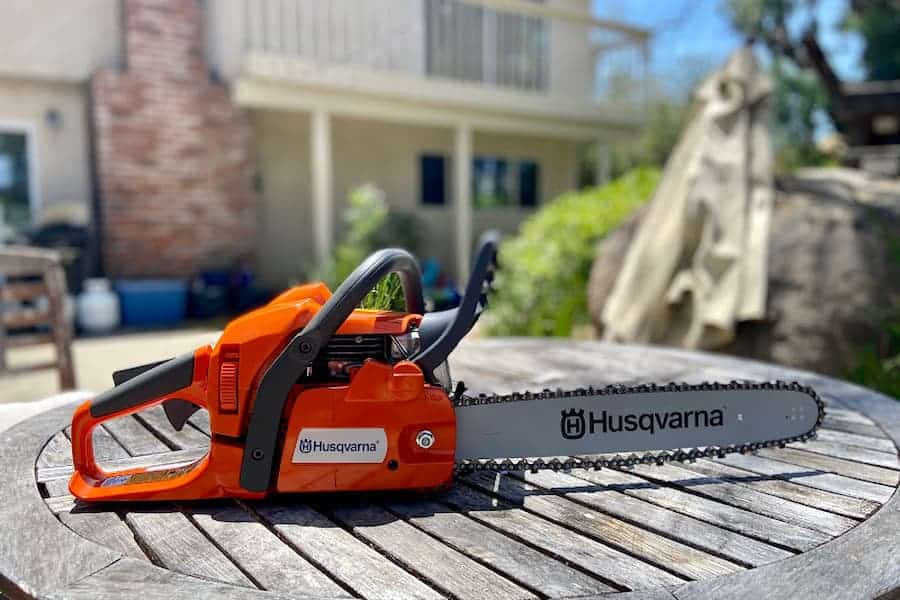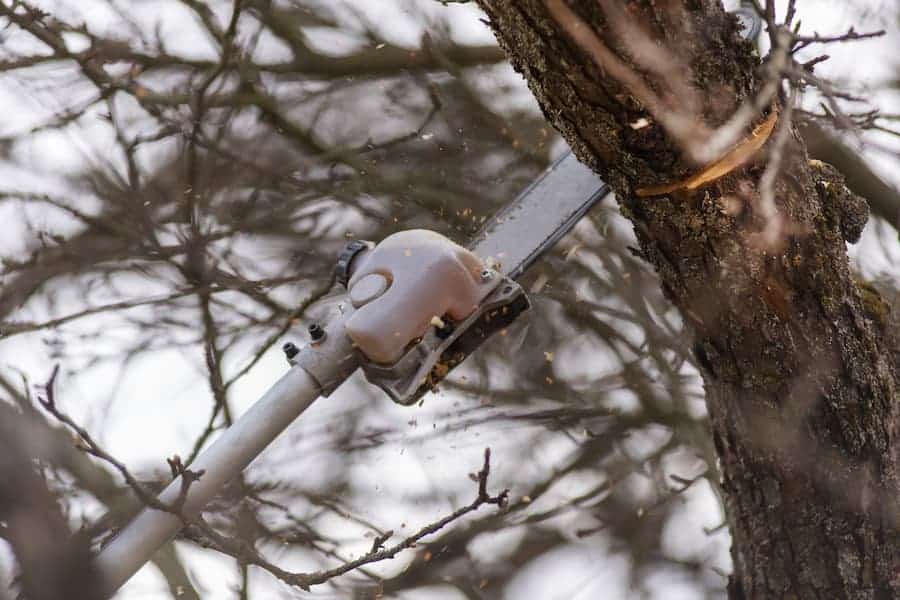When a tree branch is damaged by weather or disease, bringing it down safely is usually preferable to letting nature take its course. It’s possible to remove unsightly tree branches even from tall trees. Use this article to learn how to do this yourself, as well as when to call in a professional.
How to Cut Branches From a Tall Tree?
There are multiple ways to bring down troublesome branches from tall trees. Review the list of options below to find the best method for your unique situation.
Manual Tree Branch Cutting Methods
You can cut smaller branches and do more detailed pruning work without using power tools.
1. Use Pruning Shears and A Ladder
For the removal of small branches, you can use pruning shears.
- A tripod ladder supports itself, eliminating the need to attach the ladder to the tree.
- Keep your weight centered on the ladder throughout the cutting process. Resist the urge to overreach – it’s better to climb down and move the ladder ten times than to fall once.
- For very tall branches, you may need an extension ladder. Make sure to secure the ladder to the tree trunk or to a large tree branch that you don’t plan to cut.
Make sure to pick the right ladder for the job.
Pruning shears will only cut through thin branches. For anything slightly thick, you’ll need a stronger tool.
2. Use a Pole Pruner
Pole pruners consist of a long pole with an attached cutting head and a detachable saw blade. They allow you to cut tree branches from the ground, rather than having to get up on a ladder and get close to the branch.
- A handle at the bottom of the pole allows you to close the jaws of the cutting head.
- The saw blade is thin and arced for ease of cutting.
- Standard lengths for pole pruners are between six and 12 feet. Telescoping and extendable versions may go up to 35 or even 40 feet in length.
- Pole pruners work best for branches that are less than three-quarters of an inch in diameter.
Pole pruners are a great option if you have a lot of thin branches high up that can’t be reached with a ladder.
3. Use a Pocket Chainsaw
A pocket chainsaw is a flexible length of cutting material with a rope attached to either side.

- Use a lead rope with a small weight attached to get the pocket chainsaw into the tree.
- It may take some trial and error to get the chainsaw looped over the right branch, at the right place.
- Pull the guide ropes back and forth to move the chain against the tree branch, sawing it off.
- Make sure not to stand directly under the branch you are removing.
Powered Tree Cutting Methods
When it comes to branches larger than one inch in diameter, it’s easiest to use a power tool.
1. Use a Pole Saw
A pole saw is electric, battery, or gas-operated chainsaw attached to a long pole. The best pole saw will make short work of tall tree branches.
- Pole saws are intended to be used while standing on the ground.
- Pole saws need to be lubricated before cutting, and every 15 – 30 seconds during the cutting process. There should be a button on the motor housing that injects oil onto the blade.
- Let the chain do the cutting. Pole saws don’t require force when you are using them – just gentle, steady pressure.
- For optimum stability, don’t raise your hands above the height of your shoulders while using a pole saw.
Gas pole saws will be more powerful than their battery-operated counterparts.
2. Use an Arborist Chainsaw
An arborist chainsaw is specifically designed for tree shaping by arborists and foresters. They are also known as a top handle chainsaws.
To use, follow the same steps that you would if using pruning sheers. You’ll need to use a ladder to get close to the branches.
Chainsaws are dangerous, so you’ll need to exercise even more caution when using this method.
Tips for Cutting Branches
Following these steps will ensure safe branch removal — for you and the tree.
- Wait for the right season. Summer is a time of active new growth. When possible, avoid cutting trees in summer, as they will have a harder time healing from the injury. Most trees go dormant in the winter, so this is generally a better time to cut branches.
- Evaluate the drop zone. Before you approach the tree with a cutting implement, take some time to visualize and prepare for the branch’s path to the ground. A partially attached branch could swing or sway. Large branches falling from a great height may bounce or roll. Always stand at an angle to the limb or branch you’re working on.
- Measure branch height. Most tree-cutting tools are operated at or below shoulder height rather than close to the ground. Use a wide tape measure and extend it up the trunk of the tree to approximate the distance between your shoulder height and the top of the branch. This measurement will help guide you through your removal options, as some methods are only appropriate for branches under a certain height.
- Choose an appropriate method. Evaluate the type of tree and branch you are cutting, and choose a method that matches your needs. See the section above for more specifics about methods for cutting tree branches. Avoid using trimming tools like hedge trimmers for this job – they are not designed for branches.
- Plan for removal. Once the tree branch is down, how are you going to dispose of it? Many municipalities have designated days when landscaping debris can be picked up at the curbside. If you don’t have refuse pickup where you live, you’ll need a plan for taking the branch to a disposal location. This may mean chopping the branch into smaller pieces that are easier to transport.
- Wear appropriate safety gear. Goggles or a face shield are necessary to protect your eyes from falling debris, leaves, needles, and dust. If you’re cutting above your head, a hard hat or helmet is necessary to protect your skull from falling branches. Sturdy gloves protect your hands from scratches and scrapes.
- Undercut where possible. As you cut heavier tree branches that are high in the air, gravity will start to pull them closer to the trunk, and can cause the bark to tear away from the tree. Sawing partway through the branch from the underside before switching to sawing from the top is a good way to relieve some of this gravitational stress.

Learn how to drill into a tree without damaging it.
Where Do You Trim Tree Branches?
Cutting too close to the trunk or branch is called a flush cut. Trees have a harder time recovering from flush cuts. Instead, choose a spot three or four inches away.
When you make a cut more than six inches away from the trunk or limb, this is called a stub cut. Stub cuts may not heal properly, causing decay to spread backward into the tree.
How to Cut Tree Limbs That Are Too High to Reach
For taller trees, there are going to be situations where the tree limbs are too high for you to reach and cut.
For thinner tree limbs and branches, use a pole pruner. This tool is lightweight and doesn’t require any power, so it’s relatively easy to use. If you have a lot of limbs to cut, give yourself some time – the pruner can be a bit awkward to use and your arms will get tired.
For thicker branches and tree limbs that are too high to reach, you should turn to an electric pole saw. Pole saws are similar to pole pruners, but they are powered so they can cut through thicker branches.
You can combine a tall ladder with either pole pruners or a pole saw to reach heights of around 25ft.
If you have tree branches and limbs that are higher than 25ft, you will either need to climb the tree with a rope and harness, or rent a bucket lift. Climbing with a rope and harness is challenging and can be dangerous, especially when you climb with a power tool. Renting a bucket lift is expensive and also requires a learning curve.
When Not to Cut Branches From a Tall Tree
The most important part of any DIY project is knowing when it’s time to call a professional. Here are a few scenarios in which you shouldn’t cut branches from a tall tree.
- If any part of the tree is touching any wire, that’s one job you want to leave to the professionals. By attempting to remove the branch yourself, you expose yourself to risk of electrocution or severe electrical burns. Instead, call your local power company to inform them of the interference.
About 20% of unplanned power outages are caused by trees on the power line, so your power company has a vested interest in getting the offending limbs removed as soon as possible.
- Falling branches can do significant damage to man-made structures such as homes, garages, and garden sheds. Even steel framed cars aren’t built to resist the direct impact of a large tree branch falling on the roof. If there is even the slightest chance that a branch will fall on something other than the ground, consult a professional arborist for advice before moving forward.
- Before starting to cut branches from a tall tree, make sure any children and pets are inside the house, under responsible adult supervision.
If all of this sounds like way too big of a hassle, you could opt for an inexpensive desert landscape which would be free of tall trees.
Conclusion
There are manual and powered options for removing branches from tall trees. For smaller branches, you can use a ladder and pruning shears. Larger branches are best cut from the ground, using a pocket chainsaw, pole pruner, or pole saw.